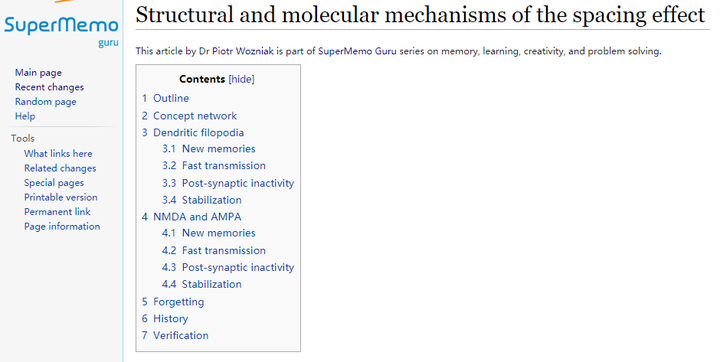原文:
Structural and molecular mechanisms of the spacing effectOutline
New memories form as new synaptic connections. When memories are in use, they may undergo stabilization by adding AMPA receptors. When memories are not in use, new dendritic filopodia may scout their surroundings for new synaptic targets. Frequent use of memory relies on fast AMPA transmission. Infrequent use may allow of filopodial growth, and allow of the activation of NMDA receptors that would (1) stabilize the synapse (adding new AMPA receptors), and (2) stabilize the dendritic arbor (incl. retraction of filopodia). Memory disuse may result in a failure of postsynaptic activation and forgetting by interference due to a takeover of the activation target by newly stabilized dendritic spines, or the reuse of NMDA-based silent synapses.
大纲
新的记忆作为新的突触连接形成。当记忆在使用时,它们可能会通过添加 AMPA 受体进行稳定化。当记忆不使用时,新的树突丝可能会侦察周围环境以寻找新的突触目标。记忆的频繁使用依赖于快速的 AMPA 传递。不经常使用可能允许树突丝的生长,并允许 NMDA 受体的激活,这将(1)稳定化突触(增加新的 AMPA 受体),和(2)稳定化树突轴(包括树突丝的回缩)。完全不使用记忆可能会导致突触后的激活失败和由于新稳定的树突棘突接管激活目标的干扰而遗忘,或基于 NMDA 的沉默突触的重用
Concept network
- the brain is a concept network
- spacing effect is necessary for the efficient optimization of memory that underlies intelligence
- a concept neuron corresponds with a single meaningful idea
- a neural link between two concepts represents a single memory
- a concept neuron is activated by a set of dendritic inputs forming the activation pattern
- in terms of spaced repetition: a combination of inputs corresponds with the decoded question. Activation corresponds with the answer
- the neuronal activity is suppressed by inhibitory input that serves activation selectivity
- a depolarization signal sent out via the axon corresponds with the activation of a concept in memory
概念网
- 大脑是一个概念网络[1]
- 间隔效应[2]是高效优化记忆的必要条件,是智能的基础。
- 一个概念神经元对应一个单一的有意义的思想
- 两条概念之间的神经联系代表了单一的记忆。
- 概念神经元被一组树突状输入激活,形成激活模式。
- 在间隔重复方面:输入的组合与解码的问题相对应,激活与答案相对应
- 抑制性输入抑制了神经元的活动,起到了激活选择性的作用
- 通过轴突发出的去极化信号与记忆中概念的激活相对应
Dendritic filopodia
树突丝
New memories
- axonal-dendritic overlap favors developing coherent memories in semantic proximity (see: Axonal-dendritic overlap favors coherence and creativity)
- formation of new dendritic spines is equivalent to building new memories in a hierarchical structure
新的记忆
- 轴突-树突重叠有利于在语义上接近的地方发展连贯的记忆(请参阅:轴突-树突重叠有利于连贯性和创造力)
- 新的树突棘的形成等同于在层次结构中建立新的记忆
Fast transmission
- filopodial growth would be kept in check by fast AMPA transmission (and halted or reversed by nearby NMDA currents in stabilization)
- fast transmission keeps a dendritic arbor relatively inert on the assumption that good use needs little change
快速传播
- AMPA 的快速传播将阻止树突丝的生长(并被附近的 NMDA 电流在稳定化中停止或逆转)
- 快速传播使树突保持相对的惰性,前提是好的使用需要很少的改变
Post-synaptic inactivity
- filopodial growth should be accelerated by low postsynaptic activity (see: Dendritic arbors undergo branching followed by stabilization)
- long periods of postsynaptic inactivity result in the growth of new dendritic filopodia in the vicinity of an active axon
- glutamate release from active axons stimulates filapodial growth via mGluR receptor
- filipodia scout the neural environment in search of attractive axonal targets. Conceptually this means that concepts seek relevant activations by other concepts
- rich filopodial growth may result in a drop in memory retrievability
- new filopodia may contribute to forgetting via interference by establishing new synaptic connections
突触后不活动
- 突触后活性低应加速树突丝的生长(请参阅:树突进行分支后稳定化)
- 长时间的突触后不活动导致活跃的轴突附近新的树突丝的生长
- 活性轴突释放出的谷氨酸盐通过 mGluR 受体刺激了腓肠肌的生长
- 树突丝搜寻神经环境以寻找有吸引力的轴突靶标。从概念上讲,这意味着概念寻求其他概念的相关激活
- 丰富的树突丝生长可能导致记忆可提取性下降
- 新的树突丝可能可能通过建立新的突触连接,通过干扰[3]促进遗忘
Stabilization
- high filopodial interference would assist the activation of NMDA receptors and stabilization of memory
- filopodial retraction should be accelerated by the stabilization of the adjacent synapses in the same dendritic arbor (see: Stabilization of dendritic spines leads to shrinkage of inactive spines)
稳定化
- 高树突丝干扰[3]将有助于 NMDA 受体的激活和记忆的稳定化
- 树突丝的回缩应通过稳定化同一树突上的相邻突触来加速(请参阅:树突棘的稳定导致无活动性棘突的萎缩)
NMDA and AMPA
门冬氨酸和氨甲基膦酸
New memories
- newly formed synapses and silent synapses are primarily populated by NMDA receptors
- synapse stabilization adds AMPA receptors to the PSD
新的记忆
- 新形成的突触和沉默突触主要由 NMDA 受体组成
- 突触稳定化为 PSD 增加 AMPA 受体
Fast transmission
- fast AMPA transmission leads to hyperpolarization that prevents the activation of NMDA receptors
- without NMDA calcium currents, stabilization is negligible, impact on inactive filipodia is less pronounced
快速传播
- AMPA 快速传播导致超极化,阻止 NMDA 受体的激活
- 没有 NMDA 钙电流,稳定化可忽略不计,对非活动的树突丝的影响不太明显
Post-synaptic inactivity
- sprouting of nearby filopodia builds up a reservoir of AMPA receptors that can be remobilized for the purpose of stabilization
- phosphorylation of AMPA receptor may contribute to memory retrievability, fast transmission, and potential activation of NMDA receptors
- NMDA-induced currents (in a stabilized synapse), in conjunction with the activation of mGluR receptor would result in retracting unused filipodia
- retraction of filopodia could allow of a transfer mobilized AMPARs to the stabilized synapse, which would enhance the spacing effect
突触后不活动
- 相邻树突丝的萌发建立了 AMPA 受体库,可将其转移以达到稳定化的目的
- AMPA 受体的磷酸化可能有助于记忆可提取性,快速传播以及 NMDA 受体的潜在激活
- NMDA 诱导的电流(处于稳定的突触中),与 mGluR 受体的激活相结合,将导致收回未使用的树突丝
- 树突丝的退缩可以使活动的 AMPARs 转移至稳定的突触,这将增强间隔效应[2]
Stabilization
- co-activation of the axon and the postsynaptic neuron may result in NMDA calcium currents that stabilize the synapse
- activation of the NMDA receptors would be more likely in case of interference from proximal filopodia
- NMDA-induced currents would favor incorporation of new AMPAR units (adding to molecular stabilization)
- increase in stability means facilitated AMPA transmission and slower growth of filopodia (see: AMPA receptors stabilize the dendritic branch)
稳定化
- 轴突和突触后神经元的共同激活可能导致稳定突触的 NMDA 钙电流
- 在近端树突丝干扰[3]的情况下,NMDA 受体的激活更有可能
- NMDA 诱导的电流将有利于引入新的 AMPAR 单元(增加了分子稳定性)
- 稳定性的增加意味着促进 AMPA 的传播和树突丝的生长减慢(请参阅:AMPA 受体稳定树突分支)
Forgetting
- forgetting would occur primarily via interference
- post-synaptic inactivity may result in a takeover of a concept neuron by new patterns based on the maturation of new dendritic spines
- prolonged disuse of the synapse can also lead to memory decay by molecular and cellular changes (e.g. phosphorylation status, subunit structure, AMPA endocytosis, cytoskeletal stability, etc.)
- prolonged disuse may result in the ultimate loss of the dendritic spine
For more see: Mechanism of forgetting
遗忘
- 遗忘主要是通过干扰[3]发生的
- 突触后的不活动可能导致基于新的树突棘成熟的新模式接管概念神经元
- 长时间不使用突触也可通过分子和细胞变化(例如磷酸化状态,亚基结构,AMPA内吞作用,细胞骨架稳定性等)导致记忆衰退。
- 长时间不使用可能会导致树突棘最终消失
有关更多信息,请参见:遗忘机制[4]
History
历史
The above reasoning is derived from the statistical properties of memory as described in the Neurostatistical Model of Memory. The data has largely been obtained by employing a spaced repetition algorithm. Statistical properties of memory make it possible to hypothesize about the interaction of the individual molecular, cellular and neural phenomena that occur while wiring the concept network of the brain in the course of development and learning. The molecular and structural interpretation is largely mine, and is based on well-documented facts of neuroscience. Some of the hypothetical assumptions are pretty bold. My boldness is justified by the idea that any falsifiable model is better than an absence of models.
上述推理来自于《记忆的神经统计模型[5]》中所描述的记忆的统计特性。这些数据主要是采用间隔重复算法获得的。记忆的统计特性使我们有可能对大脑概念网络[1]在发育和学习过程中布线时发生的各个分子、细胞和神经现象的相互作用进行假设。分子和结构的解释主要是我的,是基于神经科学的充分事实。有些假设性的假设是非常大胆的。我的大胆的理由是,任何可证伪的模型都比没有模型要好。
- I proposed the two component model of long-term memory in 1988 (for details see: Two components of memory)
- 我在 1988 年提出了长期记忆的双组分模型[6](详见:记忆的两个成分[7])。
- in Optimization of learning in 1990, I hypothesized for the first time about molecular correlates of the memory model. At that time, structural changes seemed unlikely as I was not aware of the speed of the growth of filopodia. However, glutamate, increase in the number of receptors and the calcium signal were already included in the hypothetical model
- 在 1990 年的《学习的优化》一书中,我首次假设了记忆模型的分子相关性。当时,结构变化似乎不太可能,因为我不知道树突丝的生长速度。然而,谷氨酸、受体数量的增加和钙信号已经包含在假设的模型中。
- in Economics of learning in 1995, in co-operation with Dr Edward Gorzelanczyk, we refined the model by hypothesizing about the role of NMDA receptors, mGluR, protein phosphorylation, and the possibility of exposing new receptors on the post-synaptic membrane
- 在1995年的《学习经济学》一书中,我们与 Edward Gorzelanczyk 博士合作,通过假设 NMDA 受体、mGluR、蛋白磷酸化的作用,以及在突触后膜上暴露新受体的可能性,完善了该模型。
- in the new millennium the evidence for dendritic dynamics kept mounting and it became obvious that structural changes are necessary when forming new memories. In retrospect, the whole idea of a dynamic concept network seems obvious and necessary. The reliance on solely molecular changes might be energetically prudent, but computationally infeasible
- 在新的千年里,树突动态的证据不断增加,很明显,在形成新的记忆时,结构变化是必要的。回过头来看,动态概念网络的整个想法似乎很明显,也很有必要。单纯依靠分子变化可能在能量上是谨慎的,但在计算上是不可行的。
- in 2017, mounting structural evidence resulted in my proposition of the two-component model of memory stability
- 在2017年,越来越多的结构性证据导致我提出了记忆稳定性的双组分模型[8]。
- in 2019, I concluded that the sprouting of new filopodia might be the main cause of forgetting via interference. This would make them a good candidate for memory retrievability. All we need is a good link between the activation of NMDA receptors and the retraction of nearby filipodia. That mechanism would be a solid candidate for the neural explanation of the spacing effect.
- 在 2019 年,我得出的结论是,新的树突丝的萌发可能是通过干扰[3]遗忘的主要原因。这将使它们成为记忆可提取性的良好候选者。我们所需要的是 NMDA 受体的激活和附近树突丝的回缩之间的良好联系。这种机制将成为间隔效应[2]的神经解释的可靠候选者。
- the presented model was compiled in March 2020, and should be seen as the best fit between biology and statistics as seen via the inspirational lens of spaced repetition.
- 目前所提出的模型是在 2020 年 3 月编制的,应该被视为生物学和统计学之间的最佳契合点,通过间隔重复的灵感视角来看。
Verification
Caution! The presented model of the spacing effect is hypothetical. It can still include errors, or need a major revision. However, its evolution over the last 30 years seems to indicate a good convergence with data. If you are aware of biological data that contradicts the model or is hard to explain in its light, please let me know.
验证
注意! 所提出的间隔效应[2]模型是假设性的。它仍可能包含错误,或需要进行重大修订。然而,它在过去 30 年的演变似乎表明它与数据有很好的一致性。如果你知道有生物数据与该模型相矛盾或难以解释,请告诉我。
参考
1. 概念网络 ./266541480.html2. 间隔效应 ./279166945.html
3. 干扰 ./269974053.html
4. 遗忘机制 ./265081034.html
5. 记忆的神经统计模型 ./277483881.html
6. 记忆的两个组成成分 ./179076885.html
7. 1988:记忆的两个组成成分 ./99505568.html
8. 记忆稳定性的两个组成成分 ./268782211.html

